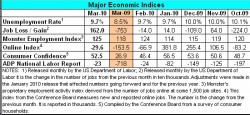The 9.7 percent U.S. unemployment rate was unchanged in March, but the economy added 162,000 jobs, the largest one-month increase in three years.
 The U.S. Bureau of Labor Statistics released its monthly employment report this morning, confirming the job growth most economists were expecting. However, the number was lower than the 200,000 new jobs that had been expected. The shortfall was attributed to Census hiring that was significantly lower than the 100,000 workers that were forecast; 48,000 were hired.
The U.S. Bureau of Labor Statistics released its monthly employment report this morning, confirming the job growth most economists were expecting. However, the number was lower than the 200,000 new jobs that had been expected. The shortfall was attributed to Census hiring that was significantly lower than the 100,000 workers that were forecast; 48,000 were hired.
The Wall Street Journal found good news even in the lower jobs number. The private sector job growth of 123,000 was higher than predictions, offering evidence that government hiring was not the primary engine of growth.
Indeed, most sectors of the economy added jobs. Construction added 15,000 jobs, a dramatic reversal from March 2009 when the industry dropped 142,000 jobs. As recently as January and February, construction jobs were disappearing at the rate of 60,000 jobs a month.
Temporary help services, considered an early predictor of job growth, added 40,000 jobs, continuing a trend that began last year. Since September 2009, 313,000 new temp jobs have been created.
The biggest lowers were in financial services and information tecvhnology, which together lost 33,000 jobs. More than a quarter of those lost jobs (9,000) came out of the insurance industry.
The positive labor reported prompted prompted guarded optimism from the chair of the White House’s Council of Economic Advisers. Christina Roemer said in a statement, “While this is the most positive jobs report we have had in three years, there will likely be bumps in the road ahead.”
For the unemployed, those bumps are beginning to look like they will never end.
The number of unemployed was unchanged at 15 million, but those now counted among the long-term unemployed, those working part time because they can’t find full time jobs, and those considered officially “discouraged” continues to grow.
The number of workers who have been without a job for 27 weeks or more increased by 414,000 over the month to 6.5 million. That’s 44 percent of the unemployed.
When you add together the unemployed, the discouraged workers, those working part time but want full time jobs and the group the BLS calls “marginally attached” the total is 26.4 million.
For these people, hope still seems far off. The Monster Employment Index, released Thursday, was all but unchanged from the month before. And other employment indices offer evidence of only slow jobs growth.
Still, the report had enough positive that trading in the future markets was up. The U.S. dollar also rose against other currencies, including the euro and the Japanese yen.
Although the stock exchanges in the U.S. and Europe are closed today for the Good Friday holiday, there was limited trading in futures and commodities markets and in bond exchanges, which had an abbreviated trading session.